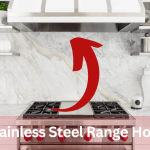A ductless range hood is a type of kitchen ventilation system that recirculates the air back into the kitchen rather than venting it outside.

It works by filtering the air through a charcoal or carbon filter before releasing it back into the kitchen.
While ducted range hoods are more common, ductless range hoods have their own advantages, particularly in situations where venting outside is not possible or practical.
In this blog post, we will explore the benefits and drawbacks of ductless range hoods, how they work, and how to choose the best one for your kitchen.
What is a Ductless Range Hood
A ductless range hood is a type of kitchen ventilation system that recirculates the air back into the kitchen rather than venting it outside.
It works by filtering the air through a charcoal or carbon filter before releasing it back into the kitchen.
Unlike ducted range hoods, which require the installation of a duct to vent the air outside, ductless range hoods are self-contained and can be installed anywhere in the kitchen without the need for complex ductwork.
Types of Ductless Range Hoods
There are several types of ductless range hoods available on the market, each with its own unique features and benefits. Here are some of the most common types of ductless range hoods:
Under Cabinet Ductless Range Hoods
These are the most common type of ductless range hood and are designed to be installed underneath kitchen cabinets.
Wall-Mounted Ductless Range Hoods
This range hood is mounted directly on the kitchen wall and is ideal for kitchens with limited cabinet space.
Island Ductless Range Hoods
They are designed to be installed above a kitchen island and can be suspended from the ceiling or mounted on the wall.
Downdraft Ductless Range Hoods
These range hoods are installed behind or on the cooktop and draw smoke and odors downwards.
Custom Ductless Range Hoods
These are designed to match the style and décor of your kitchen and are typically made to order.
Benefits of Ductless Range Hoods
Easy Installation
Compared to ducted range hoods, ductless range hoods are much simpler to install. They don’t require any complex ductwork.
This makes them a great option for renters or homeowners who don’t want to undergo extensive renovations to install a vented range hood.
Energy Efficiency
Ductless range hoods are generally more energy-efficient than their ducted counterparts. They don’t require any energy to push air through ductwork.
Over time, this might save you a lot of money on your energy expenses.
Improved Indoor Air Quality
Ductless range hoods filter out smoke, grease, and other pollutants from the air, improving the indoor air quality of your kitchen.
Those who have allergies or respiratory problems may find this to be especially helpful.
Versatile Design
Ductless range hoods are available in a variety of designs and sizes, making them suitable for any kitchen style or layout.
They can be mounted on the wall, under a cabinet, or even as a standalone unit on the countertop.
Limitations of Ductless Range Hoods
Reduced Efficiency
Ductless range hoods are not as efficient as ducted ones, as they recirculate air back into the kitchen rather than venting it outside.
This can result in a buildup of heat and moisture in the kitchen, which can be uncomfortable and even dangerous.
Maintenance Requirements
Ductless range hoods require regular maintenance to ensure their filters are clean and functioning properly.
Failure to clean or replace the filters can lead to reduced performance and potential safety hazards.
Noise
Ductless range hoods can be noisier than ducted ones, as the recirculation of air through the filters can create additional noise.
This can be especially problematic in open-concept kitchens or small apartments where noise levels can be a concern.
Cost
Ductless range hoods can be more expensive than ducted ones due to the additional components required for air filtration and recirculation.
Additionally, ongoing maintenance costs for filter replacements can add up over time.
Considerations When Choosing a Ductless Range Hood
Air filtration
Since ductless range hoods recirculate air back into the kitchen, it’s important to check the type and quality of filters they use.
Some hoods may have basic mesh or charcoal filters, while others may have more advanced multi-stage filters or even UV-C light technology.
Airflow and noise
Ductless range hoods may not have as much suction power as ducted hoods.
So it’s important to choose a model that matches your cooking needs and kitchen size.
Additionally, some ductless hoods may produce more noise than others, which can be a concern for some users.
Style and design
As with any kitchen appliance, you’ll want to choose a ductless range hood that complements your kitchen décor and personal taste.
There are many different styles and finishes available, from sleek stainless steel to decorative glass and wood.
Maintenance and cleaning
Ductless range hoods require regular cleaning and filter replacement to maintain their effectiveness and prevent odors and grease buildup.
Some hoods may have removable or dishwasher-safe filters, while others may require more involved maintenance procedures.
Cost
Ductless range hoods can be more affordable and easier to install than ducted hoods. But the initial cost and ongoing energy use may still be a factor to consider.
Some higher-end ductless models with advanced features may also have a higher price point.
Installation and Maintenance of Ductless Range Hoods
Installing a ductless range hood is a relatively simple process, as it doesn’t require any ductwork.
However, proper installation is crucial to ensure effective operation. Here are some tips for the installation and maintenance of ductless range hoods:
- Each range hood model has specific installation and maintenance requirements. Before installation, carefully read the manufacturer’s instructions and follow them closely.
- The range hood should be installed directly above the cooktop to ensure efficient ventilation. Make sure to choose a location that allows easy access for maintenance and cleaning.
- The filter needs to be cleaned or replaced regularly to maintain the efficiency of the range hood. Charcoal filters need to be replaced every three to six months, while aluminum filters can be cleaned in the dishwasher or with warm soapy water.
- The exterior of the range hood can accumulate grease and grime over time. To keep it looking clean and shiny, wipe it down with a damp cloth or a mild cleaner.
- Ductless range hoods can sometimes leak air into the kitchen, which can affect their efficiency. To ensure that the range hood is working correctly, check for leaks regularly and seal any gaps or cracks as necessary.
Cost Comparison of Ductless Range Hoods vs. Ducted Range Hoods
A range hood is an essential appliance in any kitchen as it helps to remove smoke, grease, and other impurities.
When choosing a range hood, you have two options to consider – ductless or ducted range hoods.
The main difference between the two is how they vent out the air.
Ducted range hoods are connected to a duct that leads outside the home, allowing the smoke and impurities to be released outside.
on the other hand, ductless range hoods use filters to clean the air and release it back into the kitchen.
One of the factors to consider when choosing between the two is the cost.
Generally, ductless range hoods are less expensive to install than ducted range hoods because they don’t require any ductwork.
However, ductless range hoods require more maintenance as the filters need to be cleaned or replaced periodically, which can add to the overall cost.
Ducted range hoods are more expensive to install due to the cost of ductwork, but they require less maintenance than ductless range hoods.
Once installed, ducted range hoods are more efficient at removing impurities from the kitchen and venting them outside, leading to a healthier and cleaner environment.
In terms of long-term cost, ducted range hoods are often considered more cost-effective because they are more energy-efficient than ductless range hoods.
Ducted range hoods also increase the value of the home, making them a better investment for homeowners.
Ultimately, the choice between a ducted and ductless range hood depends on your budget and your kitchen’s specific needs.
It’s important to weigh the upfront cost against the long-term benefits to make an informed decision.
Conclusion
In conclusion, ductless range hoods are a great option for kitchens where ductwork is not possible or practical.
They offer several benefits, such as ease of installation, flexibility in placement, and cost-effectiveness.
However, they also have some limitations, including reduced effectiveness in removing smoke and odors and the need for frequent filter replacements.
When choosing a ductless range hood, it is important to consider factors such as the size and layout of your kitchen, cooking habits, and the type of filter required.
Additionally, it is important to weigh the costs and benefits of a ductless range hood versus a ducted range hood to make an informed decision that fits your needs and budget.

Freda is a passionate foodie and kitchen gadget enthusiast. With over 10 years of experience in the culinary industry, Freda brings her expertise in testing and reviewing kitchen gadgets.




